The 2006 aerobatic season is underway. In fact, fully one-third of the California contests are already in the books. I finished in second place at the Borrego MiniFest and a distant sixth at Apple Valley. I haven’t written anything about it as yet, mainly because I’ve been too busy flying to write about flying.
This is a good thing.
But let me back up and talk about how I got here.
As I wrote in December, my career in aerobatics was at a crossroads after last season. I wanted to move up to Intermediate, but couldn’t do so in the Super Decathlon. After running the financials, and thanks in no small part to the experience of owning Tweety for several years, I bought into a partnership in an Pitts S-2B.
I’m sure you’ll all want to see the art work before I drone on about the mundane details of aircraft ownership, so here are some photographs that were taken at the L.A. Gold Cup competition last month:
In the words of George Costanza, “Yeah, she’s a sweet ride”. This is true as much because of the circumstances as the actual airplane. See, this isn’t just any S-2B. It’s an aircraft which is on leaseback where I work. It’s available for checkouts and solo rental — one of the few Pitts Specials that you can fly solo, I might add.
The rarity of solo rentals has made N1191 very popular. We have folks who regularly come from as far away as Japan to fly it. The leaseback revenue has been high enough that it keeps the partners cost extremely low. Much moreso than I’d be able to swing with any other partnership, let alone if I were to buy an aircraft outright.
A partnership also made sense because it’s unlikely any friction will develop between the owners about who takes the plane for the weekend. A Pitts is not a good cross country aircraft. It’s cramped, noisy, and uncomfortable. It was designed for one thing: aerobatics. As such, when it leaves the area, it’s probably going to be enroute to a competition. And all the owners will be going, too. So where scheduling is concerned, our desires are nearly always aligned.
Finally, as anyone who’s been in an aircraft partnership will tell you, these arrangements are akin to a marriage: you’re attached financially and personally to the other owners. So you better get along. And the partners in this aircraft were already a known quantity to me. I’d spend time with them at competitions, seen how they treated the airplane, and knew we’d be a good match because we’re already friends.
I also like the fact that the airplane isn’t moving to a new home. It’s been based at SNA for more than a decade. The maintenance and upkeep will be done by the same people who’ve managed it since day one. I don’t have to worry about where to hangar the aircraft (it’s already got one), how much the insurance will cost (the same as it did before I owned it), and what the tax consequences will be (there are none).
Of course, there has to be a down side, right? Nothing’s free. In this particular arrangement, what I’m giving up is the freedom to fly the plane whenever I want. We have a scheduling system that everyone, even the owners, must use. If I want to fly it tomorrow morning and it’s already booked, I’m out of luck. But at a total cost of operation of $85/hour, this is a limitation I can live with. I just have to plan my flights a little further in advance, that’s all.
If I learned anything from owning my other aircraft, it’s that the purchase price is a small piece of the financial puzzle. An engine overhaul or airframe repair can easily blow your budget wide open, no matter how much money you hold in reserve. Case in point: the canopy on the Pitts has been lost before. One time it wasn’t latched properly. Another time the jettisoning mechanism had worn beyond limits and the canopy fell to the ground after a flight. This is a $5,000 part. An engine overhaul is in the $30,000 range. Prop overhauls are more than $2,000.Â
As the saying goes, a few thousand here, a few thousand there, and pretty soon you’re talking about real money.
Speaking of mishaps, I can already recount a Bad Day I had with N1191. It was at the last competition. I was in a hurry to refuel the airplane after my flight and get over to the judging line. Everything was fine until I reached into my pocket to grab the fuel strainer. I couldn’t find it. Turns out that I had left the strainer in the fuel hose extension (where it is stored), and when I put fuel in the plane, the pressure of the 100LL going into the tank had dumped the fuel strainer into the tank as well.
You should have seen the look on my face when I realized what had happened. I spent the next two minutes cursing myself with the most colorful idioms. From what I’ve been told, it was quite entertaining. I figured that the competition was over for me. And the other partners. Nice way to join the group, don’t you think?Â
In the end, the day was saved by the fuel truck driver. He somehow managed to fish the strainer out of the tank using nothing but an 18″ spring loaded claw, flashlight, and one of those magnetic doo-dads that are used to pick up washers and screws from hard to reach places. I don’t know how he did it. If you look at a photo of the Pitts, you’ll see that the acro tank filler cap is only a few inches from the bottom of the top wing, leaving very little space to even get your head in there and see what’s going on, let alone fishing something out of the tank.
I could have hugged him. But instead I pulled out my wallet and said, “I don’t know how much is in here, but whatever it is, please take it!” He wouldn’t hear of it, but I at least managed to buy the guy lunch.
One of the owners later told me that years ago, something similar had happened. The difference is that when they went about retrieving the fuel strainer, they didn’t find one in the tank, they found three.
Good times.
I’ve got about 25 hours in the plane now, and my impressions are generally good. It’s certainly a higher performance bird than the Super D, but I sometimes fail to account for the tremendous drag presented by the airframe. On the way back from Apple Valley, I flew in formation with the Extra 300 and had to apply full power to keep up with it. The Extra was running at about 15″.
I wish I’d have learned that lesson sooner. I zeroed a figure at that competition because I fell out of an inverted lay out after a vertical roll. And I had entered the maneuver at nearly Vne! The high drag and wing loading are especially apparent during any attempt to “glide”. I use the word in quotes because a better adjective might be “fall”. It comes nearly straight down. On an extremely tight downwind, if I pull the power abeam the runway numbers, I barely make the runway from 1300′ AGL. They should consider using the S-2B to train shuttle pilots…
I have a high level of respect, maybe even a little fear, of the Pitts.  Oh, not because of spins. I’ve spun it every possible way and it exits even the most aggrevated spin mode beautifully. No, I’m talking about the structure. The structure is extremely light. I don’t see a whole lot of crashworthiness in the plane. Combined with the poor glide ratio, high landing speed, and landing gear configuration, it certainly must give one pause when thinking about engine failure scenarios. When Gray and I ferried the Pitts and Extra out to Apple Valley in marginal VFR last month, I asked to fly the Extra because flying at 2000′ AGL for any length of time in the Pitts just made me very uncomfortable.
In closing, I will note that the Pitts has a legendary reputation as an unpredictable and highly difficult airplane to land.  From what I can tell, the reputation is undeserved. The Pitts, like any other airplane, will do what you tell it to do. I found the transition to be easier than moving into the Extra 300. Once you get the sight picture down and can roundout low enough, it’s no different than any other aircraft. Get the nose straight. Stop the drift. And when it’s on the ground, keep it going straight.
Now, if you never learned how to do those things in other aircraft, the Pitts is certainly capable of teaching you a lesson you won’t forget. But it’s not a machine that will disobey pilot input.
So that’s it. A new adventure begins!
Now. Who wants to go for a RIDE??

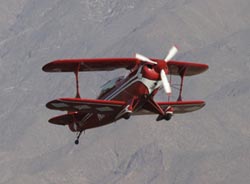
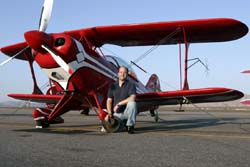
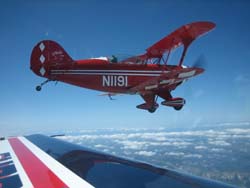
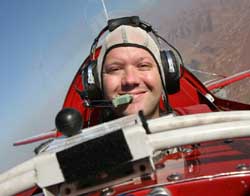
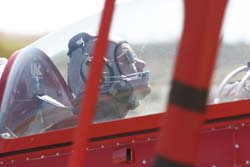
Are you cweet?
ME!ME!ME!ME!ME!ME!ME!ME!!!!!!!